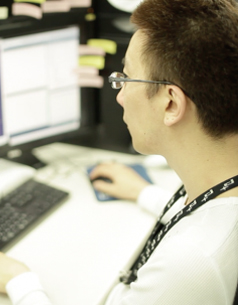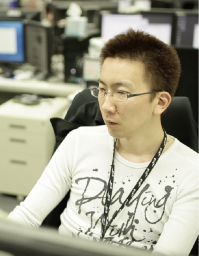Wataru Ohmori, CTO & Head of the Technology Strategic Planning Team
Looking at Things from a Programmer’s Perspective
Including announced but not yet released games, PlatinumGames has worked on 10 titles to date. The skills our employees have cultivated during these projects are our greatest asset. To preserve this knowledge, and to stay relevant in an ever changing market, we created what we call the Technology Strategic Planning Team. Programmer Ohmori, the founder and current leader of the TSPT, talks about what it’s like behind the scenes.
Supporting Game Development from Behind the Scenes
 I’m the head of the Technology Strategic Planning Team, a department that single-handedly bears responsibility for the core technologies that make our games tick. We don’t work on the design of individual games, but rather over-arching technologies, such as developing a system to archive data from each development line, or improving the general resources shared between all projects. It’s kind of similar to what other companies call an engine or a library. Sometimes this means developing a whole system based on the needs of each project, and sometimes we approach the heads of each project with suggestions on how we think things can be improved. We’re in charge of a very important part of development that the player will never get to see directly and would probably be bored by if they did.
I’m the head of the Technology Strategic Planning Team, a department that single-handedly bears responsibility for the core technologies that make our games tick. We don’t work on the design of individual games, but rather over-arching technologies, such as developing a system to archive data from each development line, or improving the general resources shared between all projects. It’s kind of similar to what other companies call an engine or a library. Sometimes this means developing a whole system based on the needs of each project, and sometimes we approach the heads of each project with suggestions on how we think things can be improved. We’re in charge of a very important part of development that the player will never get to see directly and would probably be bored by if they did.
For example, a sound designer may come to me and say “When I’m checking the game, I want to be able to see what kind of sound is being played where; can you have that displayed in real time?” These are the type of requests we take. We add these functions based on the needs of a particular project, but if they work well, we adopt them in some or all of the other projects too.

It wasn’t just me who pushed for this department; the support of Executive Producer Atsushi Inaba was invaluable. If you’re going to make several games at one company, you’ll need corresponding development teams in place for each title. While the demands of each project are different, there are always certain technologies that can be shared between multiple projects. Before the TSPT, every time we’d start a project, a new person would be in charge of system development and would rebuild everything. It goes without saying that this is terribly inefficient. If you are going to be using a lot of the same functions between projects, it makes sense to coordinate everything under one unit. We’d been discussing creating such a unit for a long time, but to actually make it a reality meant taking a number of our most experienced staff off other projects. This would be easy to do if we were a huge company, but PlatinumGames is still relatively small, so we were bit nervous about realizing this plan. At first I was a bit unsure myself, but after seeing the burden the old method was putting on the teams, and with Inaba-san’s support, I decided to go all out to make the TSPT a reality.
To be honest, there are times when we can be a bit of a burden to the other departments. We do process a lot of requests from the various projects, but there are some that are still on our to-do list… Overall, when I see how the tools we provide are being used throughout the company, it’s clear that our quality is getting better and better. As our tools are used, people will start having extra demands, which in turn also leads to extra bugs that need to be sorted, but as long as there’s a use for those tools, we’ll keep squashing those bugs and making the tools more resilient. To create a better development space demands a continuous process of improvement upon improvement.
(Continues to Part 2.)
interview by editorial studio MUESUM (2012/07/13)